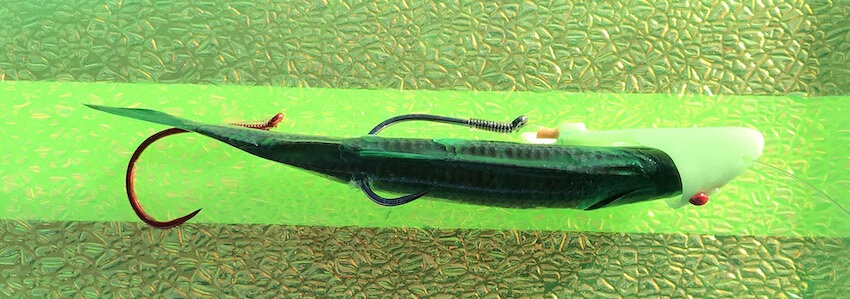
On the west coast of Vancouver Island and closer to Vancouver, flasher and anchovy is often the fishing method of choice. It is very effective in midsummer, when schools of anchovies push north into the area and anytime there are a lot of sand lance or immature herring around and the salmon are feeding on small bait.
There are many different anchovy/teaser head colour combinations available. I keep it simple and use green glow in green water conditions and blue or purple haze when the water clears.
The traditional method is to use a Rhys Davis anchovy teaser head with a tensioning toothpick and lead treble hook, set to bend the anchovy into a gentle curve. Anchovies are soft, however, and quickly take on a sharp bend just behind the gills, ruining the roll. A better method is to rig the teaser head with a piece of 18 gauge (0.0403-in diameter) stainless steel wire which is inserted in the anchovy parallel to the backbone, holding the curve and providing a very reliable roll. This wire is readily available at marine supply stores where it is sold as “locking wire.”
Most anchovy teaser heads are pre-drilled with two small holes for the wire. A 4-in piece of wire works well (this is longer than necessary; in the boat compare it to the length of the bait and cut the wire so it ends just past the dorsal fin). Insert the wire into the anchovy and bend the bait into a gentle curve. I prefer a “bullet roll,” similar to a spinning pencil. The greater the bend in the anchovy, the wider the roll.
Many fishermen use a #4 or #2 treble as the lead hook, which works well for smaller salmon. In my experience, the treble reduces the chances of a missed strike but can pull out during a long fight with a big Chinook. Trebles also make it difficult to release smaller salmon; coho in particular tend to tangle the line very badly with trebles. For these reasons, I generally use a pair of single hooks. Pass the lead hook through the anchovy so the point sticks out on the opposite side and leave the trailing hook hanging free with the end roughly level with the tail of the anchovy. Use the tensioning toothpick to take up any slack in the leader.

Top view showing lead hook placement
My leaders are similar to the ones I use for cut plug and teaser head herring, but with a closer spacing between the hooks and heavier line due to the flasher. I begin with a 7-ft piece of 40-lb Maxima Ultragreen line and tie in a 4/0 Gamakatsu trailer using the bumper knot, followed by the 4/0 Gamakatsu lead hook with a separation of 2 inches between the end of the lead hook and the end of the trailing hook (I admit that these hooks look enormous beside a little anchovy, but we are fishing for big salmon).
Bill Haymond is the author of “The Science of Salmon Fishing”, which is available at www.thescienceofsalmonfishing.com.
This article appeared in Island Fisherman Magazine. Never miss another issue—subscribe today!
One Comment
Leave A Comment
Visit the Store
$34.99
$34.99
Featured Catch

Joel Unickow halibut (Photo: Rob Frawley Lucky Strike Sportfishing Tofino)









Great info on flashers and hoochies, will try the heaver leaders thanks